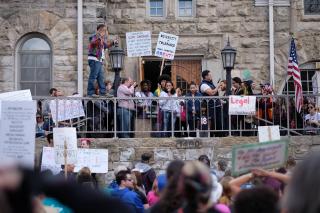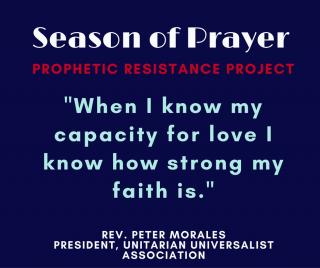Physical Sanctuary
Physical sanctuary is an intensive, short term tactic to house and shelter people who are typically at risk of immediate deportation. This can protect an individual or family as part of a focused legal strategy. It is one of the ways that people of faith and conscience can promote sanctuary, which also includes advocating for sanctuary policies in cities, counties, school districts and on college campuses, and joining sanctuary community protection networks in local communities. Congregations who offer physical sanctuary do so as part of a greater movement of radical, faithful resistance.
Key resources for physical sanctuary
- Download the Sanctuary Toolkit - Download this comprehensive toolkit for congregations ready to explore offering physical shelter in their building to someone under threat of deportation or police action. This is one specific, high-commitment way to support people who are under threat because of their status, religion, race or identity. The toolkit touches on other ways to provide sanctuary, such as advocating for sanctuary city policies or investing in community protection networks. Published by the UU College of Social Justice and UURISE.
- Sign the pledge - Sign this interfaith pledge to resist deportation and discrimination through sanctuary, sponsored by the New Sanctuary Movement. Get your congregation connected to the national network of faith communities offering physical sanctuary.
- Read sanctuary statements - The Unitarian Universalist Association has adopted statements to support sanctuary immigration reform since its founding in 1961. Read a summary of these statements here.
- Find sanctuary commitments - This list includes Unitarian Universalist congregations and organizations that have committed to offering physical sanctuary. NOTE: this list does not indicate whether these groups are currently sheltering anyone in sanctuary or not.
- Webinar Faithful Discernment: Is Your Congregation Called to Offer Sanctuary? - Wondering what your options might be for effective congregational action in this heightened time of hostility and violence and possible deportations? This video is a recording of one webinar in a series on Sanctuary & Solidarity, hosted by UUSC,UUA,UUCSJ, andUURISE. In this session,Katia Hansen, President and CEO of UU Refugee & Immigrant Services and Education (UURISE) presents what it means to become a Sanctuary congregation and what factors to consider in assessing whether your congregation is able to answer this call to solidarity with individuals affected by the escalating xenophobia and increased deportations threatened by the new administration. As becoming a Sanctuary congregation is one of the many ways to be in solidarity with those most at risk in this new political landscape, it also offers additional resources and ideas for taking action.
- Webinar The Path Toward Sanctuary: A Practical Guide - Katia Hansen, President and CEO of UU Refugee & Immigrant Services and Education (UURISE) discusses the "nuts and bolts" of becoming a sanctuary congregation for those that have already discerned that they have the capacity and commitment to continue down this path. It also includes the experiences of ministers whose congregations have undergone the process of becoming a sanctuary church and those who have found other ways to take action for rights of immigrants and refugees.
Partners for physical sanctuary
- UURISE (Unitarian Universalist Refugee and Immigration Services and Education) - Tools, resources, contacts and events for Unitarian Universalists working for immigration justice.
- New Sanctuary Movement - An interfaith coalition of congregations and religious leaders committed to offering physical sanctuary.
History of physical sanctuary
The sanctity of faith communities has deep historic roots, going back to Hebrew temples in the time of the Roman Empire. During the medieval period, the English common law allowed an accused felon to seek sanctuary in a church for protection before trial. This practice can trace its influence to today, where the United States Immigration and Customs Enforcement has a policy of limiting enforcement actions in "sensitive areas" like church buildings.
Since the 1980s, Unitarian Universalists have supported physical sanctuary for immigrant families in danger of being deported. Individual congregations participated in the Sanctuary Movement, an interfaith movement rising up in response to the Central American refugee crisis. When a New Sanctuary Movement arose in 2007, Unitarian Universalists joined other faith leaders in condemning immigration enforcement raids that tear families apart. Today, Unitarian Universalists work for immigration justice and continue to support physical sanctuary as one pathway of solidarity.
For one congregation's story read The Road to New Sanctuary (PDF, 5 pages): How the Unitarian Universalist Congregation of Danbury Joined the Movement.

